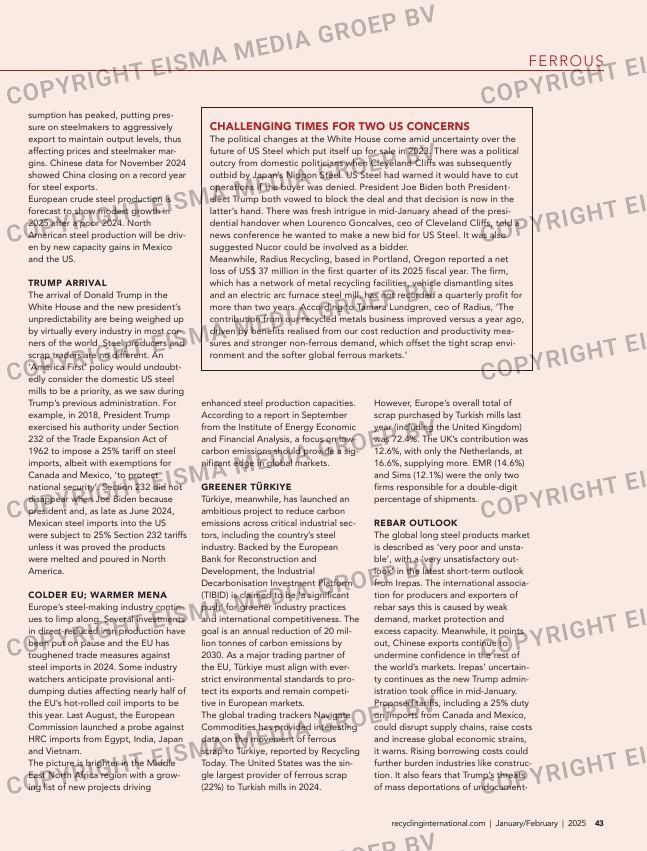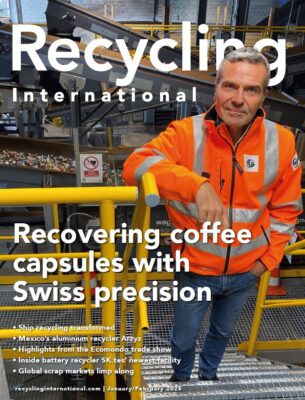Page 43 from: Recycling International Jan/Feb 2025

FERROUS
New Year, old concerns
43recyclinginternational.com | January/February | 2025
sumption has peaked, putting pres-
sure on steelmakers to aggressively
export to maintain output levels, thus
affecting prices and steelmaker mar-
gins. Chinese data for November 2024
showed China closing on a record year
for steel exports.
European crude steel production is
forecast to show modest growth in
2025 after a poor 2024. North
American steel production will be driv-
en by new capacity gains in Mexico
and the US.
TRUMP ARRIVAL
The arrival of Donald Trump in the
White House and the new president’s
unpredictability are being weighed up
by virtually every industry in most cor-
ners of the world. Steel producers and
scrap traders are no different. An
‘America First’ policy would undoubt-
edly consider the domestic US steel
mills to be a priority, as we saw during
Trump’s previous administration. For
example, in 2018, President Trump
exercised his authority under Section
232 of the Trade Expansion Act of
1962 to impose a 25% tariff on steel
imports, albeit with exemptions for
Canada and Mexico, ‘to protect
national security’. Section 232 did not
disappear when Joe Biden because
president and, as late as June 2024,
Mexican steel imports into the US
were subject to 25% Section 232 tariffs
unless it was proved the products
were melted and poured in North
America.
COLDER EU; WARMER MENA
Europe’s steel-making industry contin-
ues to limp along. Several investments
in direct-reduced iron production have
been put on pause and the EU has
toughened trade measures against
steel imports in 2024. Some industry
watchers anticipate provisional anti-
dumping duties affecting nearly half of
the EU’s hot-rolled coil imports to be
this year. Last August, the European
Commission launched a probe against
HRC imports from Egypt, India, Japan
and Vietnam.
The picture is brighter in the Middle
East North Africa region with a grow-
ing list of new projects driving
A U T H O R Robin Latchem | P H O T O Shutterstock
European domestic demand to persist,
providing a bearish outlook for
European export scrap prices in 2025.
MILL POWER
Scrap recyclers told Commodity
Insights they were pinning their hopes
on increased costs of collecting HMS
at the docks helping to keep CFR
Türkiye scrap prices firm in Q1. But
since the New Year, sources said, sub-
suppliers have unsuccessfully attempt-
ed to increase their prices while recy-
clers have simultaneously struggled to
push costs down.
With persistently weak scrap demand
from European domestic mills and
alternative export destinations like
India remaining muted, some recycler
sources suggested that passing on any
higher scrap collection costs to the
Turkish mills would be difficult consid-
ering the mills’ buying power and
alternative steelmaking input options
such as billets. This was despite
Turkish crude steelmaking capacity
increasing almost 11% year-on-year in
2024 to 65.75 million tonnes and
import volumes increasing 6.2% year-
on-year from January to November to
18.18 million tonnes.
In the second half of 2024, market par-
ticipants also noted that any uptick in
deep sea prices attracted too many
recyclers to sell into the Turkish mar-
ket, which capped any sustainable
upward momentum in spot scrap pric-
es as eager sellers rushed to book
deals.
CRUDE ABOUT-TURN
Global crude steel production is
expected to increase modestly in 2025
over 2024 levels, the first annual
increase since 2021, which followed
the 2020 Covid shutdowns, according
to Fastmarkets. Higher production in
North America, Europe, the Middle
East and India should offset the
expected weak year in China, it said.
Domestic Chinese apparent steel con-
CHALLENGING TIMES FOR TWO US CONCERNS
The political changes at the White House come amid uncertainty over the
future of US Steel which put itself up for sale in 2023. There was a political
outcry from domestic politicians when Cleveland-Cliffs was subsequently
outbid by Japan’s Nippon Steel. US Steel had warned it would have to cut
operations if the buyer was denied. President Joe Biden both President-
elect Trump both vowed to block the deal and that decision is now in the
latter’s hand. There was fresh intrigue in mid-January ahead of the presi-
dential handover when Lourenco Goncalves, ceo of Cleveland Cliffs, told a
news conference he wanted to make a new bid for US Steel. It was also
suggested Nucor could be involved as a bidder.
Meanwhile, Radius Recycling, based in Portland, Oregon reported a net
loss of US$ 37 million in the first quarter of its 2025 fiscal year. The firm,
which has a network of metal recycling facilities, vehicle dismantling sites
and an electric arc furnace steel mill, has not recorded a quarterly profit for
more than two years. According to Tamara Lundgren, ceo of Radius, ‘The
contribution from our recycled metals business improved versus a year ago,
driven by benefits realised from our cost reduction and productivity mea-
sures and stronger non-ferrous demand, which offset the tight scrap envi-
ronment and the softer global ferrous markets.’
enhanced steel production capacities.
According to a report in September
from the Institute of Energy Economic
and Financial Analysis, a focus on low-
carbon emissions should provide a sig-
nificant edge in global markets.
GREENER TÜRKIYE
Türkiye, meanwhile, has launched an
ambitious project to reduce carbon
emissions across critical industrial sec-
tors, including the country’s steel
industry. Backed by the European
Bank for Reconstruction and
Development, the Industrial
Decarbonisation Investment Platform
(TIBID) is claimed to be ‘a significant
push’ for greener industry practices
and international competitiveness. The
goal is an annual reduction of 20 mil-
lion tonnes of carbon emissions by
2030. As a major trading partner of
the EU, Türkiye must align with ever-
strict environmental standards to pro-
tect its exports and remain competi-
tive in European markets.
The global trading trackers Navigate
Commodities has provided interesting
data on the movement of ferrous
scrap to Türkiye, reported by Recycling
Today. The United States was the sin-
gle largest provider of ferrous scrap
(22%) to Turkish mills in 2024.
However, Europe’s overall total of
scrap purchased by Turkish mills last
year (including the United Kingdom)
was 72.4%. The UK’s contribution was
12.6%, with only the Netherlands, at
16.6%, supplying more. EMR (14.6%)
and Sims (12.1%) were the only two
firms responsible for a double-digit
percentage of shipments.
REBAR OUTLOOK
The global long steel products market
is described as ‘very poor and unsta-
ble’, with a ‘very unsatisfactory out-
look’ in the latest short-term outlook
from Irepas. The international associa-
tion for producers and exporters of
rebar says this is caused by weak
demand, market protection and
excess capacity. Meanwhile, it points
out, Chinese exports continue to
undermine confidence in the rest of
the world’s markets. Irepas’ uncertain-
ty continues as the new Trump admin-
istration took office in mid-January.
Proposed tariffs, including a 25% duty
on imports from Canada and Mexico,
could disrupt supply chains, raise costs
and increase global economic strains,
it warns. Rising borrowing costs could
further burden industries like construc-
tion. It also fears that Trump’s threats
of mass deportations of undocument-
42-43-44_maferrous.indd 43 29-01-2025 11:28



